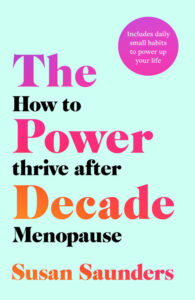In a nutshell: This eminently sensible guide to ageing well is based on the premise that the years immediately after the menopause transition are the most important for a woman’s health. These years – roughly between our mid-fifties and mid-sixties – are the ideal time to take stock, decide on the kind of future we want and take action to align our habits and behaviours with this vision of the future.
“Healthy ageing is about taking control, preparing our minds and bodies for what should be the best years of our lives”, writes the author Susan Saunders, who is also co-founder of The Age-Well Project.
Don’t miss: The section on powering up physical and mental health, which delves into some of the persistent symptoms – such as disrupted sleep, night sweats, brain fog and hot flushes – that can persist into the post-menopausal years.

Author of The Power Decade and co-founder of The Age-Well Project, Susan Saunders
In the chapter on prioritising sleep, Saunders outlines the possible causes of sleep issues in the power decade and lays out a range of small daily habits that can help. One suggestion is to have a small, strong cup of chamomile tea before bed.
“Don’t have a giant mugful; you’ll be up all night going to the loo. Think of it like an espresso, but one that will help you sleep rather than keep you awake”, she suggests.
Thumbs up: There’s something profoundly liberating about rejecting the pervasive narrative that says that life after the menopause is the start of a slippery slope into decrepitude and old age. This practical guide lays out the preventative steps and small daily changes that can illuminate the pathway to a bright, powerful future.
Try this: Feeling stressed or finding it difficult to sleep? Try this simple breathwork technique from The Power Decade:
A physiological sigh
Invented back in the 1930s, this simple breathwork technique can be used to improve both stress and sleep levels, which are so closely linked. It blows carbon dioxide out of your lungs quickly: one aspect of the stress response is having too much CO2 in the bloodstream and lungs, so blowing off CO2 rapidly calms the brain and nervous system. Take a long, strong inhale through the nose into the diaphragm, until almost at full capacity. Then take one more quick, short burst, getting a little extra air into the lungs. This short top-up breath opens up the alveoli and allows access to the CO2 they’re holding on to. Then take a long, slow exhale through the mouth, to offload that CO2 build-up. Two or three breaths are enough for a calming effect, or try ten to fifteen to help you sleep.
- The Power Decade: How to Thrive After Menopause by Susan Saunders (Headline Home, £16.99) is out now.

Lead picture credit: Pete Alexopoulos on Unsplash
Author’s profile image: Vanessa Sotto

